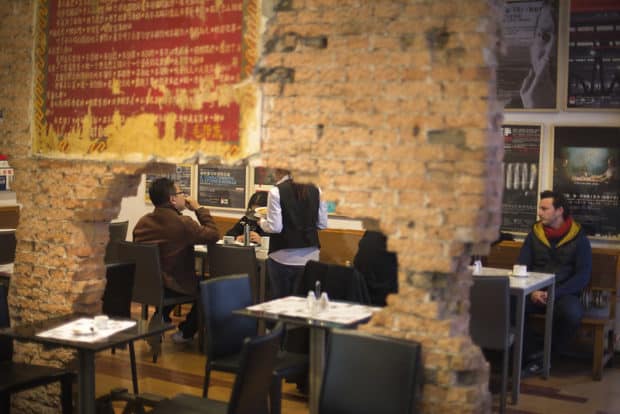Last Updated on December 8, 2023
China has been slow to adopt coffee culture, but it’s now the fastest-growing market in the world, slowly ushering in the Third Wave and innovating along the way.
There is no singular Chinese culture, but a diversity of customs and preferences throughout the country. Coffee culture follows this geographic tendency, ranging from high-tech, top-tier cities that demand novelty and excitement, to small farming communities where people may even grow the beans but have never themselves consumed a single cup of coffee.
Tea still dominates as the country’s beverage of choice, and will likely remain so, but coffee is becoming increasingly popular—both as a Western symbol of status and prestige, and a favored choice for that afternoon pick-me-up.

The history of Chinese coffee culture
Although historically a tea drinking culture, China has had coffee since the mid-1800s. As coffee was spreading throughout the world, it found its way to China, and a couple of cafes popped up around Shanghai—including Shengchang Cafe which, although not in its original form, still exists today. Cafes, however, were few and far between, and coffee remained a highly specialized product with little cultural significance for nearly a century.
Western influence
As China’s economy began to globalize in the 1980s and 90s, Western influences began to permeate the once-isolated culture. Starbucks would be one of several global brands to capitalize on the massive, rapidly modernizing population. The first Starbucks opened in Beijing in 1999, but Chinese people were still slow to adopt both coffee and cafe culture. Even in 2006 it was difficult to find coffee shops outside of Western hotels or tourist areas. Instant coffee was being embraced for home use, but buying coffee from a cafe was still the purview of the wealthy and well-traveled business elite.
Rise of the millennials
Enter the millennials. Those born between 1981 and 1996 make up a quarter of the current population in China. Many belong to the new middle class, with disposable income and an insatiable appetite for Western culture. Millennials are driving consumption in China, and are responsible for nearly half of all luxury goods purchased.
Coffee might not seem like a luxury product, but it China it is very much viewed as such. The cost of doing business in China is low compared to places like England or the U.S., for example, but the price of a cup of coffee is higher. This is a strategic choice by both mainstream brands like Starbucks and Costa Coffee, as well as more artisanal cafes. The Chinese coffee market associates higher cost with higher quality.
Regardless of the cost, coffee consumption in China rose over 1,000 per cent between 2008 and 2018.
Riding the Second Wave
China seems to be stuck in the Second Wave of coffee, with international coffee chains still dominating the Chinese market. Cafes in China are far more experiential, about seeing and being seen rather than a high-quality cup of coffee. There are some smaller, more artisanal cafes and domestic chains popping up, but judging by the sugary and over the top creations often found in Chinese cafes, it seems the coffee itself takes a back seat to the status of holding the right cup.
Current Chinese coffee culture
It’s about the cup, not the coffee
Coffee consumption in China is seems to be more about status than taste. The most popular style of coffee for home use is instant coffee, pre-mixed with creamer and sweetener or flavoring of some sort to essentially mask the coffee’s actual flavor.
Younger generations craft their identities around consumption—the more Western products you consume, the higher your status. Younger Chinese are also more international, with many going abroad to study. They often return with a taste for Western products and culture.
Being seen in a hip cafe is far more important to them than the actual product consumed. This lack of coffee appreciation has helped larger mainstream brands dominate the Chinese market.
Dominated by megabrands
Starbucks opened its first location in China in 1999. It was a slow build over the next decade, but since the late 2000s the brand has expanded rapidly. China is now Starbucks’ fastest-growing market, with a new store opening ever 15 hours.
The largest and fanciest Starbucks in the world is in Shanghai—a multilevel experience with a roastery, innovation centre, and high-end chocolate shop. It’s beyond what any of us would imagine a Starbucks to be, and it’s popular with tourists and locals alike.

International megabrands have found a lot of success in China, particularly in the last 15 years, but local brands—one in particular—have attempted to take advantage of this boom in consumption.
The Luckin Coffee saga
Luckin Coffee burst onto the scene in 2018, opening 4,500 shops in just two years! They were set on overtaking Starbucks, and took a novel and modern approach. Luckin locations are primarily take-away kiosks, with ordering done via a smartphone app. This runs counter to the previous ideology that Chinese coffee consumption centered around the space itself as a place to socialize with friends and increase one’s status. Grab-and-go coffee at a reasonable price didn’t seem to have a place in this tea-drinking culture. Yet Luckin skyrocketed in popularity, and it wasn’t the business model that led to its potential downfall, but management of the company.
Scandal rocked Luckin in 2020, when it was discovered that millions of dollars of transactions had been faked to increase the value of their stock. Both the CEO and COO were dismissed and Luckin was slapped with a $180-million-US fine. Despite the turmoil within the company, support for the brand appears to have held strong. The company recent filed for bankruptcy, and their future appears murky, but they certainly proved that China has a growing appetite for local, affordable, and convenient coffee options.
The slow rise of the Third Wave
Coffee itself is slowly becoming more popular, and with it China is ushering in the Third Wave of coffee. Smaller independent coffee shops are beginning to thrive. Seesaw Coffee led the way, opening their first coffee shop in Shanghai in 2012. They now have 23 shops in major cities throughout the country, and are heralded as the pioneers of domestic specialty coffee. They’ve paved the way for other local brands like SOE, Metal Hands, and Voyage Coffee, which are smaller chains that choose to focus on quality and community rather than rapid expansion.
Diversity of taste and culture
Community is important in China. So are traditions. In many parts of the country, people hold on tightly to their local identities. Successful brands not only realize this, but cater to it.
There is no single Chinese culture, but a diversity of tastes and demands. In Shanghai, for example, the appetite for the new and exciting is insatiable. Cafes must produce fun seasonal offerings and constantly be evolving and adapting their menus. Beijing, in contrast, has a more historic and artistic vibe. People there favor dependable, neighborhood shops with a community vibe. They want to get to know their barista, and they prefer classic drinks and a more relaxed pace.

Chengdu, a newer, more modern city, is trendy but laid back. People want to hang with their friends and enjoy the space. They don’t tend to have particular demands or complicated tastes, but are more focused on the experience itself.
Keeping it local
Coffee has been cultivated in Yunnan province since the late 1800s. These are predominantly mid-grade Arabica beans grown for export to foreign markets, most notably Germany. China has imported lower grade Robusta beans from just over the border in Vietnam, and made most of it into instant coffee, full of sugar. But a trend toward supporting the locally grown beans from Yunnan province is beginning to take hold.
As demand for high-quality coffee increases, so dos the domestic market for the loftier Arabica beans. People like Bryan Rak of Lanna Coffee are pushing to keep things local. Bryan organized a tasting for coffee growers in Yunnan, many of which had never tasted the end product of their hard work. Although most of them still prefer tea, it’s part of his company’s mission to engage the local communities and bring attention and appreciation back to a coffee’s place of origin.
What to order in China
You can find almost anything in China, and that includes a wide range of classic coffee beverages, and some unbelievable custom creations. If it’s a strong, simple, cup of coffee you’re after, that will be tougher to find. You’ll want to seek out a small artisanal shop, or try your luck at one of the thousands of Starbucks or Costa Coffee outlets.
For a more truly Chinese coffee experience, prepare yourself for something closer to a decedent dessert. It’s taken a few decades for China to warm up to the taste of coffee, and this has resulted in a combination of weak coffee and a lot of sugar. You’ll often find coffee beverages loaded with whip cream, sprinkles, and layers of sugary flavoring. Take the iconic Sweet Little Rain from Shanghai’s Mellower Cafe, a cup of steaming coffee with a cloud of cotton candy suspended above it. The steam melts the cotton candy, “raining” the sugary substance into the coffee, creating an intense sweetness that basically negates the coffee altogether.
View this post on Instagram
Should you find yourself in the industrial city of Suzhou, check out 36th Story for a more restrained and romantic take on a Chinese coffee shop. Owner Max Wang is a true coffee lover, crafting layered (and yes often sweet), complex and unique beverages on a foundation of excellent espresso.
Coffee isn’t an afterthought at 36th Story, and you can certainly tell. Order a straight espresso and you won’t be disappointed, but you’d be better off indulging in one of Max’s signature creations with mango or rose.
The shop itself is a whimsical blend of European elegance and Chinese kitsch and he has a loyal band of regulars who have followed him as he’s moved shop twice in need of bigger locations.
Rather than compete with the megabrands, Max has created an oasis that offers the highest quality coffee while remaining unapologetically Chinese.
Final thoughts
China is a rapidly modernizing country. What is hip and in favor today might well be gone tomorrow.
The huge population offers a seemingly endless market, and the growing upper middle class is fueling an unprecedented culture of consumption.
Starbucks has been successful in slightly adapting their classic offerings to suit whatever culture they’ve chosen to invade, but I wager it will be the likes of Max Wang who create the future of Chinese coffee culture, and that’s something to certainly keep your eye on.
Image at top: © Alexa | Creative Commons


